How to Develop an eCommerce Website: Full Overview

For any online business, a retailer’s website is a fundamental resource. eCommerce website development entails building a captivating virtual storefront that appeals to clients and fosters the expansion of your company. This guide will assist you in mastering the processes required to produce a website that raises sales in addition to drawing in visitors.
If you wish to create an eCommerce website, you must zero in on designing and building a platform that is merely aesthetically pleasing and functions flawlessly. A cluttered experience sends shoppers running. Keep things sharp, functional, and polished to make the journey from homepage to checkout feel like a breeze.
The best eCommerce web development avoids reinventing the wheel. It’s about smart choices and sustainable structure. If you’re eyeing long-term wins in sales, Limeup lends a helping hand with our high-end retail solutions that will move the needle.
What is eCommerce website development?
Allow us to begin with the main magic of eCommerce software development, where a digital storefront is assembled to stand out and make customers eager to click that “buy” button. It’s where visual narrative and technological accuracy come together to make the purchasing process as seamless as butter. A well-designed site is supported by an engine that manages safe payments, products are updated and buyers are able to return without any problems.
Within this field, programmers, designers, strategists work together to develop an eCommerce website and sculpt a holistic experience, far exceeding the simple act of page assembly. Interactions should remain smooth throughout, even when the underlying technology is intricate.
Behind the scenes of every high-converting shop lies a blueprint: resilient architecture, logical flows, and pressure-tested systems. This core structure is invisible to most visitors, but without it, design is just decoration. When form aligns with function, the brand starts to communicate in a voice that resonates with customers. A store lacking identity won’t engage, yet one that exhibits personality, consistency and clarity will foster loyalty and encourage return visits.
Speed plays a leading role. A few seconds of delay may send carts flying out the window. Security walks hand in hand with performance: SSL encryption, fraud protection, secure payments. Inventory needs to stay accurate, integrations must play nicely together and the on-screen behavior should feel just as intuitive as desktop.
For growing businesses, custom eCommerce website development also means planning ahead. Will the store need multilingual support? Complex product variations? Real-time analytics? Handling all of this without reinventing the wheel requires smart infrastructure and forward-thinking logic. That’s why partnering with a professional eCommerce development company becomes essential for building scalable, high-performing solutions tailored to your business goals.
And while some companies get stuck wrangling off-the-shelf themes, others team up with experts who can craft a custom solution from the ground up. Limeup helps retail sellers lay the groundwork for eCommerce environments that start strong and stay the course, no matter how fast the market shifts.
Types of eCommerce websites
B2C (Business-to-Consumer). Probably what comes to mind first. Sites like these connect brands directly with individual shoppers. Clean layouts, product reviews, and one-click checkouts make the frictionless ride from browse to buy.
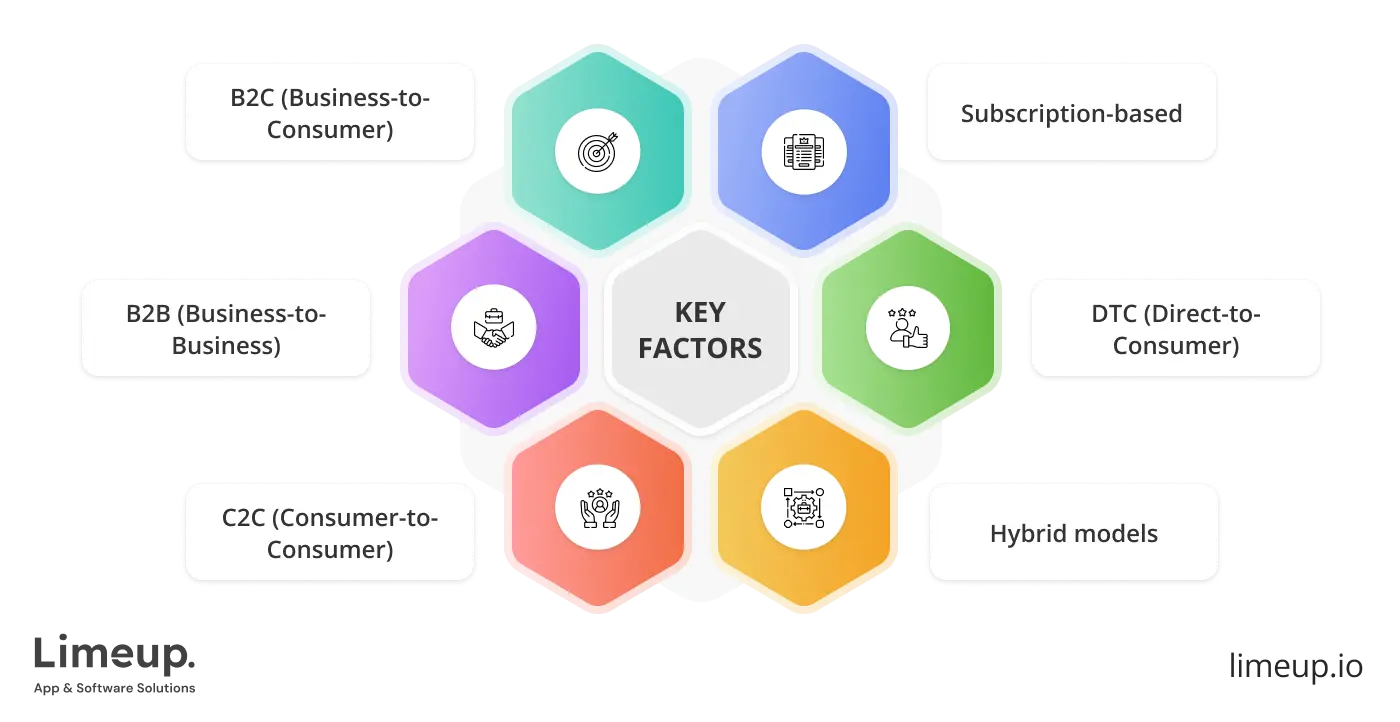
B2B (Business-to-Business). Organizations that sell to other companies may find their solution here. For B2B operations, the rhythm leans toward practical mechanics such as bulk order flows, pre-agreed pricing tiers and personalized quote chains.
C2C (Consumer-to-Consumer). Sellers and shippers interact directly in peer-to-peer marketplaces, with trust mechanisms in place and easy access to features, all without outside involvement.
Subscription-based. Sites that offer regularly delivered products or services handle recurring billing, manage account preferences and maintain customer engagement with precision — aspects that benefit greatly from the wisdom of a knowledgeable eCommerce web development company.
DTC (Direct-to-Consumer). Retailers that cut out the middleman and talk straight to their customers. Strong visuals, tight messaging, and fast performance are critical.
Hybrid models. Blending B2B with B2C means creating split-yet-seamless user flows and maintaining performance behind the scenes, even when demands peak.
Our team advocates for forming alliances with trusted web development firms in the UK and other parts of the globe to achieve a standout product.
How to create eCommerce website: step-by-step guide?
Construction of eCommerce site is an exercise in balance, where design, logistics, user experience are all interwoven to produce a high-performing digital store that feels effortless to consumer. Each phase in the process calls for thoughtful decisions and a steady hand to bring everything together. Here’s a step-by-step breakdown to help get your digital shelves stocked and selling.
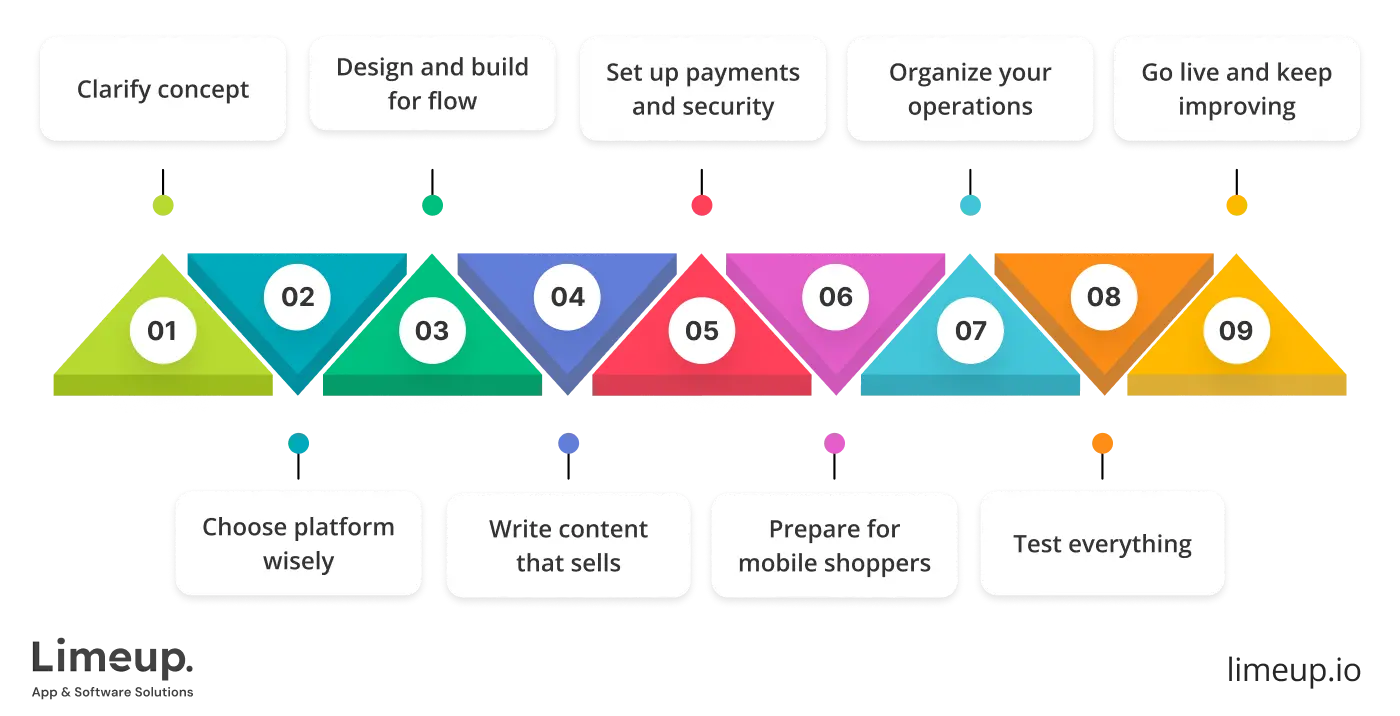
Step 1. Clarify concept
Start developing an eCommerce website by concentrating on the broad picture, comprising your target audience and the specifics of your service. Even while it might seem simple, ambiguous responses at this point may lead to disorganized, useless websites. The groundwork for all future economic moves is laid by defining your specialty, imagining your ideal client, and figuring out what makes your store different.
Step 2. Choose platform wisely
Your choice of tech stack influences not just launch speed but also how much room you’ll have to evolve and integrate as needs shift. We may only add that mobile app development companies for eCommerce understand how to read the fine print in portal capabilities, ensuring you’re not trading speed for sustainability.
Step 3. Design and build for flow
As you understand, here, layout moves beyond surface polish and begins to carry real weight. A thoughtfully designed eCommerce site guides rather than overwhelms, creating a cohesive path from arrival to checkout without drawing unnecessary attention to itself. Every part of the interface, from the structure of the menu to the placement of visuals, works quietly in the background to make the experience feel natural and intuitive.
Step 4. Write content that sells
A dull pitch won’t move products. If the layout speaks confidence and the words strike the right chord, your site becomes a silent salesperson. Believe us, strong headlines, purposeful language and coordinated messaging give visitors a reason to explore instead of bounce.
Step 5. Set up payments and security
Now’s the moment when the eCommerce web developer sharpens the checkout flow, knowing it’s what may seal or sink the sale. Keep it simple, fast, familiar. Integrate trusted payment gateways and ensure every transaction is wrapped in robust security. Shoppers want convenience without second-guessing their safety.
Step 6. Prepare for mobile shoppers
These days, most carts are filled on phones. Your store should look and work great on any screen size. Buttons need room to breathe, text should scale properly, and images must load quickly. Don’t give users a reason to swipe away.
Step 7. Organize your operations
From shipping to taxes, logistics may be the messy part, unless you plan wisely. Our team knows that it is better to connect your inventory system, automate routine tasks and set clear delivery expectations. This part might not be glamorous, but it’s what keeps orders flowing and customers smiling.
Step 8. Test everything
Before the curtain rises, every detail deserves a close inspection. We recommend exploring the entire store as a customer would: click through pages, simulate purchases, scrutinize every corner for flaws. As the saying goes, “a stitch in time saves nine,” and in web development for eCommerce, early fixes prevent costly chaos. Thorough preparation transforms a risky rollout into a confident entrance.
Step 9. Go live and keep improving
A store going live signals day one, not the grand finale. The real work lies in tracking performance, listening to users, and fine-tuning every detail. eCommerce rewards those who adapt quickly, question constantly, and never settle.
With the knowledge we’ve passed along you’re now armed with a deeper understanding of how to create an eCommerce app. After breaking down the process, one thing stands out: ambitious brands trust Limeup to shape online stores that run smoothly, expand naturally, and never leave them playing catch-up.
What are the key features of custom eCommerce web development?
Every element in construction of a personalized eCommerce website is built to reflect how your brand thinks, speaks, and sells. It creates the platform for an online experience in which each click, scroll, and swipe makes sense. Contrary to box solutions that hold creativity back in a straitjacket, a custom build leaves room to grow, adapt, and innovate with confidence.
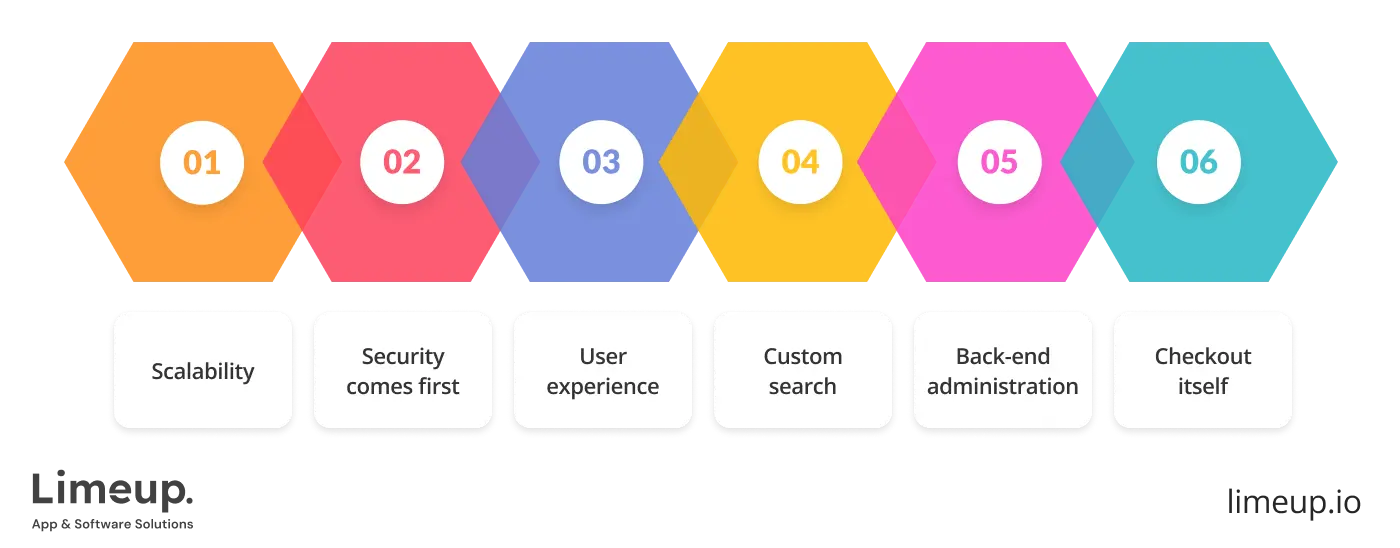
One of the first things that sets a great platform apart from a forgettable one is scalability. Business needs evolve, traffic spikes, product offerings multiply, and what was working efficiently six months ago can start to groan under the pressure. A custom solution gives room to grow from the start. It allows the infrastructure to scale in line with the brand without hitting surprise ceilings or having to apply Band-Aids later on.
Security stands front and center. In website development for eСommerce, trust holds more weight than the transaction itself. Buyers demand airtight data protection, flawless payments and clear signs that security measures weren’t an afterthought. It means encrypted transactions, secure admin controls, GDPR compliance, intrinsic defense features that deflect cyber attacks before they can reach.
User experience(UX) is the other core foundation. People do not buy friction online. They want simplicity, speed and intuitive personalization, not manufactured. A purpose-built platform enables behavior-based recommendation, dynamic content, smart search functionality, and temperate navigation. This is the online equivalent of a store assistant who recognizes your name and knows what you are looking for before you ask.
Custom search and filter rules may also rethink how individuals navigate around a site. When consumers are able to locate what they are looking for in a matter of seconds, satisfaction increases and bounce rates decrease. Disorganization, conversely, is akin to a messy shop floor — it drives individuals away. Let an eCommerce website developer tame the chaos — filters that follow catalog logic keep visitors browsing, not bolting.
Behind-the-scenes administration of an eCommerce website also plays a massive role in long-term success. Staff must be able to update stock, manage promotions and process orders without needing to call on a developer every time. A tailored back office gives the team tools built around their workflows. When the system is serving them, not hindering them, things get done faster and with less hassle.
The checkout itself deserves its own highlight. This is act four, where good design and sensible flows complete the sale. A clunky, slow checkout is where abandoned carts are built. A straightforward, distraction-free path that accepts all common payment types builds momentum instead of losing it. Custom eCommerce websites development also allows for add-ons like saved carts, guest checkout and shipping calculation that remove surprises and excuses.
Limeup builds eCommerce websites with that in mind. All of it works as a part of a larger, long-lasting image, and each characteristic has a purpose. Businesses that collaborate with Limeup are not held back by cookie-cutter templates or gimmicks. They get systems that reflect their strategy and stay stable as markets evolve.
An eCommerce build should run like a well-oiled machine, where mobile features, admin tools, and design flow without pulling in opposite directions. When design, performance, and usability all go hand in hand, the result is a platform that invites clients in and returns them again.
How long does it take to build an eCommerce website?
Release of a site that sells takes steady planning and smart action. The timeline is based on the complexity of the project and how ambitious the goals are. Some stores assemble quickly, while others need more time in the workshop.

A dozen or so products in a tiny boutique shop with plain navigation may be set up faster than you can yell out “shopping cart.” But if what you’re after is a platform with custom functionality, integrations, multi-language, or regional tax logic, the road gets longer and it should.
- Planning
During this stage, everything is on the table: business goals, buyer personas, user journeys, framework selection. Rushing through it is like building on sand. A good foundation pays dividends later when the actual work is executed. Allocating a few weeks for research and discovery allows the online eCommerce website development crew to map out priorities and iron out surprises before they occur halfway through the project.
- Design
It is when it all begins to come together visually and starts to express the personality of the brand. Designers work closely with stakeholders to ensure that the look and feel speak to the right crowd. By itself, this stage can take 3 to 6 weeks, depending on any revisions. Exceptional design is the product of continuous testing, feedback loops, and adjustments that refine usability with each iteration.
- Development
Writing a custom checkout flow or piecing together multiple third-party APIs can’t be done on autopilot. Each function gets accessed after eCommerce web design & development, refined and tested again. Depending on size, this phase may vary from 4 weeks to 3 months. Payment gateway integration, database design, mobile friendliness, and performance optimization are all required.
- Content
Descriptions, images, and taxonomy are the backstage crew making sure your store shines on day one. Though often overlooked, this is enough to slow down progress to a crawl unless an owner exists. Scheduling shoots, nailing down copy, and ensuring consistency in tone all take time, especially for businesses juggling hundreds of SKUs.
- QA
Testing is carried out across browsers, devices, and screen resolutions. The team identifies bugs, streamlines UX, and prepares the site for traffic. Budget another few weeks here, depending on how polished things have to be.
Limeup generally takes retail teams through this timeline in a real and transparent way. Instead of racing around in circles trying to achieve perfection, our eCommerce website development process is kept down-to-earth, moving through sequential steps with hardly any leeway for guessing. The team makes timelines realistic and in tune with business goals, not merely how they must appear.
An eCommerce site that is completely functional might be completed in 8–16 weeks, or more for projects requiring enterprise demands or elaborate functionality. There is no magic time clock, but with a good plan, sharp minds, and a clear vision, you can avoid detours and stay on track. After all, building something that lasts is rarely a rush job.
What is the cost of eСommerce web development services?
eCommerce website is not something you budget as groceries — the cost depends on ambition, complexity and the kind of buying experience you want to offer. A skeleton store with few features will not drain as much from your pocket as a featureful platform built for thousands of products and global transactions.
Begin with the bones: a basic site with pre-made templates and fewer features could cost between $5,000 and $15,000. Creating an eCommerce website like this covers standard design, payment integration and product setup, enough to get started, but not ready to scale or differentiate.
You will spend between $20,000 and $50,000 if you want a more intuitive interface with sophisticated graphics, unique flows, and mobile-first responsiveness. A refined shopping journey with customizable purchase paths, user-friendly dashboards, and adjustable wishlist features is the result of blending performance, interaction and design.
For infrastructures serving large inventories, multiple roles, integrations with CRMs or ERPs and fully custom features, you’re looking at $60,000 to $150,000+. This level demands close collaboration with senior eCommerce web developers, project managers, designers and QA testers. All components, such as search filters and back-end dashboards, are thoughtfully adjusted for precise demands.
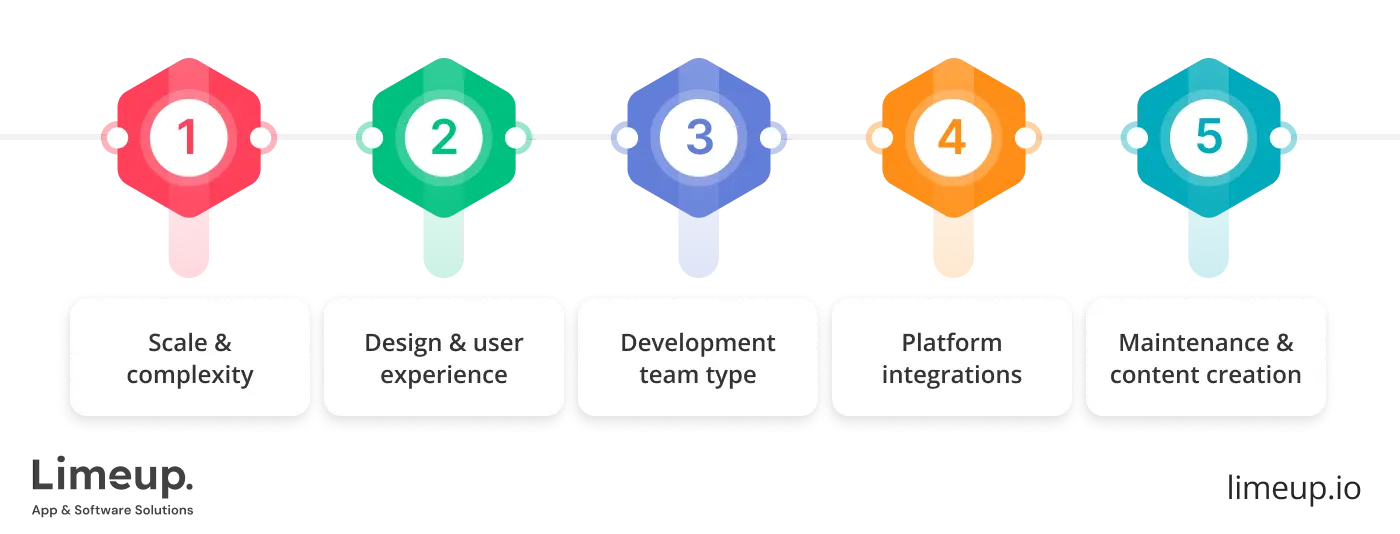
Content creation is the unsung hero of every successful online shop. The brand’s primary beliefs are reflected in the rich tapestry assembled from carefully chosen words and visuals. Speed has no seat at this table, only strategy and style. Add in constant upkeep, security updates, server fees, third-party applications and the price just keeps going.
Fun fact: investigations indicate that buyers make their initial impressions of a product within 90 seconds, underscoring the significance of having visually appealing products in the market.
To give you a clearer sense of the financial commitment, we’ve broken down typical pricing tiers based on the proportions and intricacies of the undertaking:
| Project tier | Description | Estimated cost (USD) |
| Starter build | Basic template, limited features, single-language site | $5,000 – $15,000 |
| Mid-range custom | Custom design, optimized UX, responsive layout, basic integrations | $20,000 – $50,000 |
| Large-scale eCommerce | Advanced features, API integrations, CMS, multiple currencies/languages | $60,000 – $150,000 |
| Enterprise endeavor | Fully tailored system, ERP/CRM integration, scalability, complex user logic | $150,000+ |
Building an eCommerce website at Limeup, projects are sized based on real requirements, not assumptions. What you pay depends on the pace, the platform and the people, every venture sets its own tempo.
eCommerce website developers’ pricing
Hiring web developers in a smart way sets the tone for future success. A lean quote might look tempting on paper, but watch your step as low upfront rates often come with hidden tolls down the road. Coders who skimp on quality or miss the mark on interface may leave you with a mess that’s more costly to clean up than it would’ve been to do correctly from the start.
| Developer type | Hourly rate | What you’re actually buying |
| Freelancer (budget) | $15 – $40 | Quick fixes, templated code, and a prayer your cart doesn’t crash. |
| Mid-level agency | $50 – $120 | Solid builds, decent UX, but scalability may get fuzzy at the edges. |
| Top-tier product studio | $120 – $200+ | Scalable architecture, seamless UX, tight security, future-ready logic. |
| In-house hire | $70k – $150k/year | Deep product knowledge, but comes with hiring, training, and overhead. |
It is not a place to play fast and loose. Going for the cheapest strategies for developing eCommerce websites might save a few dollars now, but if the portal breaks under pressure or underwhelms your customers, that “savings” evaporates in lost sales and brand damage.
A well-built eCommerce environment pulls its share of the business effort. It brings in conversions, handles traffic like a pro and scales with your business. That kind of dependability doesn’t happen by accident. It’s the result of savvy technologists, analytical foresight and deliberate choices, not bargain-bin shortcuts.
You wouldn’t build your home with second-rate materials. The same logic applies to your eCommerce site. The right investment up front avoids costly patches down the line. Limeup approaches engineering with longevity in mind, we design digital spaces that are able to handle tomorrow’s growth without today’s shortcuts.
How to select the provider for eCommerce website design and development?
Hiring a partner for your eCommerce website is not something you do to mark something off your list between lunch and your next meeting. This choice has an impact on your company. This is the team that crafts the environment where your business runs daily operations, expands its reach, and drives profit.
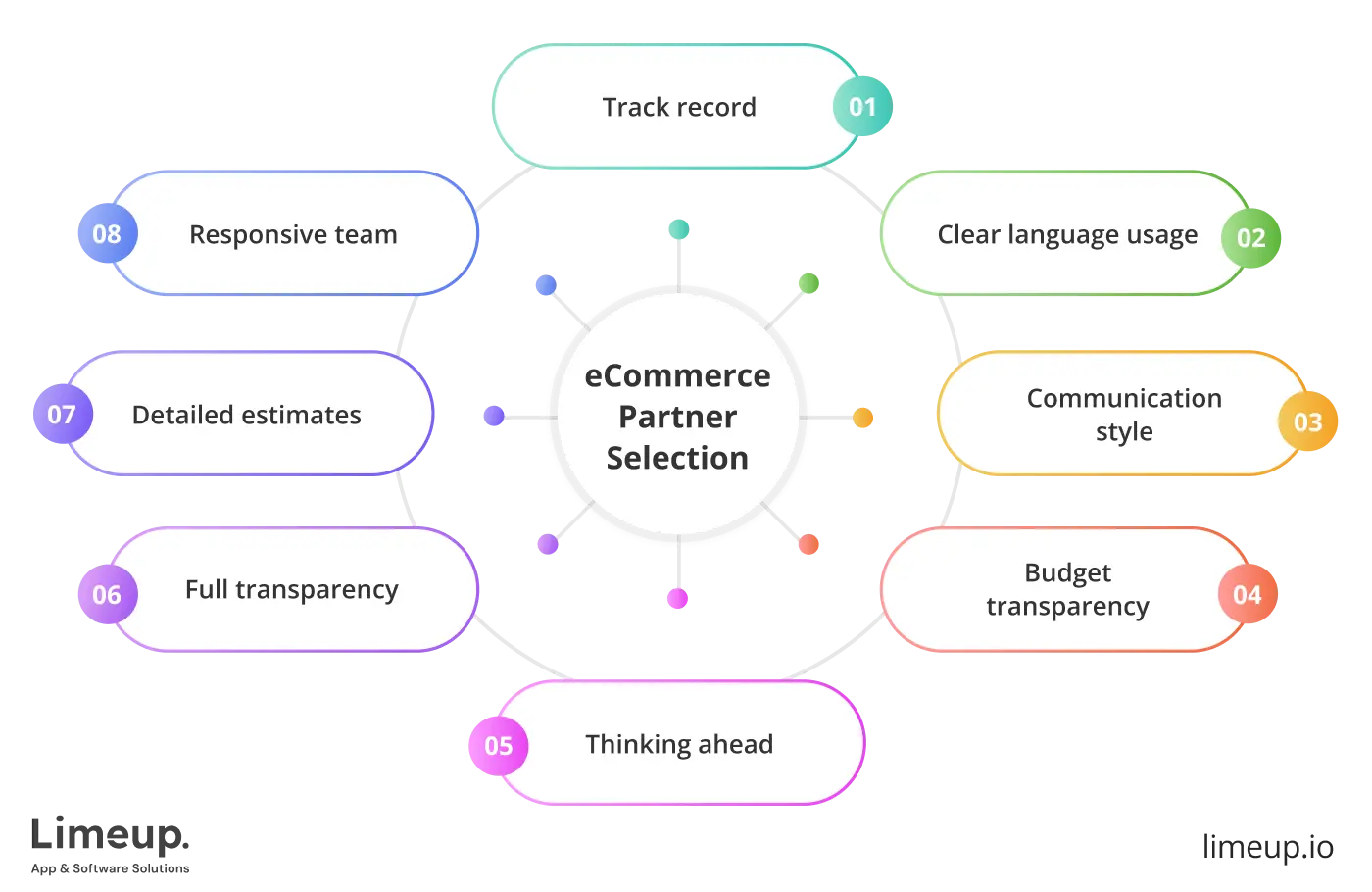
Start with their track record. You don’t hire a chef to taste their food and you don’t trust a firm without seeing their work in the wild. You should look beyond shallow screenshots. Did the last work web design agencies for eCommerce result in more conversions? Do their websites load fast, feel intuitive, and deliver under stress? Solid delivery does the real talking. What we recommend paying attention to:
- Good portfolio: old work should show functionality, not graphics.
- Results to show: look for performance measures, not mockups.
- Industry knowledge: specialized knowledge trumps general ability.
After the introduction, observe how they engage. A skilled vendor of eCommerce website development services uses clear language and digs deeper with meaningful questions about your customers, business structure, and challenges. If the conversation starts to feel like a scripted pitch rather than an open exchange, that is a signal their focus may be elsewhere. Some of the good signs are:
- They dig beneath the surface: instead of jumping straight to tools, they focus on timing, strategy, and the bigger picture.
- They don’t nod to everything: expect pushback where it counts. A strong partner questions assumptions and brings clarity, not compliments.
- They connect business with build: features aren’t decorations—they stem directly from what your business is trying to achieve.
Communication style of future companion is another hard-to-miss signal. Lateness, mumbling responses and radio silence won’t cut it. A good provider lays out timelines in plain language, checks in frequently, and talks tech in plain language.
- Defined project roadmap: every phase has a name, a date, and a deliverable.
- No jargon traps: you know what’s being built and why.
- Responsive team: you don’t have to wait a week to get a response on a blocker.
Understanding how to build an eCommerce website begins with recognizing that the mastery of technology matters most but not nearly as much as the methods behind its utilization. Every clever agency shapes their technology selections based on what your business requires. You want craftsmanship, not cookie-cutter.
- Right, not just shiny tech: tools should resolve issues rather than generate more problems.
- Custom when it counts: there are limitations to standard solutions, but unique solutions go beyond them.
- Future-focused: a serious coding team thinks in systems, not just screens.
From the side of the eCommerce engineer of websites, budget transparency isn’t up for debate. Surprises should be on your homepage, not your invoice. It is always better to get everything in writing: design scope, revisions, integration plans, testing, hosting, post-launch support.
- Detailed estimates: no vague “starting from” numbers.
- Agreed-upon revision rounds: you know exactly how many tweaks are included before the meter runs.
- Post-deployment care framework: a growing store needs just as much attention behind the scenes as out front.
If your website is going to expand, new markets, product lines, altered checkout processes, you need an eCommerce website design & development crew thinking five steps ahead. Limeup, for instance, works with brands that are looking to expand long-term. Their job doesn’t stop at delivery. They stay tuned in to keep the platform sharp and steady.
And lastly, trust your instincts. If your internal logic throws an error, don’t ignore the stack trace:
- No pressure tactics: the powerful agency doesn’t make the decision on the spur of the moment.
- Full transparency: you get to know the people, not just the pitch.
- If the vibe’s off, progress stalls: communication and atmosphere can make or break the relationship.
The good provider has accuracy, competence and genuine interest in your success. When the people behind the build act like they’ve got skin in the game, the results speak for themselves.
How to ensure the security of your eCommerce website?
Trust is money in eCommerce. Consumers will only put their hands in their pockets if they feel secure doing so. From day one, security must be treated as a core feature, not something to be retrofitted later. And when trust has been lost, it’s difficult to glue together again.

Start with the basics, but don’t stay there — SSL certificates are your front line. They encrypt confidential data, showing you mean business with protection. Believe us, without it, browsers yell warnings, conversions drop and your brand looks like it skipped the memo on modern etiquette.
As our time in the field as a highly-rated eCommerce website development company shows, confirming who’s knocking is as important as locking the door behind them. You’d better encourage passwords that are stronger, have multi-factor authentication and restrict the number of logins with caps and lockout. Brute-force bots love weak doors, don’t give them one.
Then there’s the admin panel, control room of your digital storefront. Tuck it away from plain sight. Change default URLs, limit access by IP when possible and treat every admin login like it’s a bank vault. No one should wander in through an unlocked side door.
You’d better keep your systems sharp as updates should follow releases, not your calendar. In the realm of eCommerce web development services, delaying puts your site in the crosshairs. Unpatched themes and plugins attract the wrong kind of attention, and what starts as a small breach can turn into a major cleanup job.
Firewalls and security plugins are worth their weight. Web application firewalls (WAFs) reject malicious traffic before it hits your site and malware scanners pick up bad code like digital bloodhounds. Include these pieces of software in your regular maintenance, not something you turn on and forget.
Many organizations overlook the ongoing nature of security. It isn’t a one-off task, but a continuous process that requires consistent attention. Much like a garden, it needs regular nurturing to stay strong and protected. Scan for threats, clean up access roles and store backups somewhere far from your primary environment.
At Limeup, we understand the vulnerability of digital ecosystems. That’s why defense is never an afterthought as it’s integrated from the very beginning. Our eCommerce site development team approaches every project as if it were their own business at stake—no shortcuts, no assumptions. Here’s a quick mental checklist:
- Use HTTPS across every page.
- Enforce strong password policies.
- Set up two-factor authentication.
- Obscure and secure your admin panel.
- Keep software updated.
- Choose a trusted payment gateway.
- Run regular security scans.
- Automatically back up daily.
- Limit user access to the fundamentals.
Customers cannot see the majority of these safeguards, but their effects are evident. When a website functions well, reacts fast and doesn’t trigger security issues, it fosters silent trust that motivates action. Strong protection is not a sign of fear but of preparedness. It demonstrates a company that is risk-averse, dedicated to stability, and unwilling to let luck determine success.
Why choose Limeup for your eCommerce site development?
Emerging technology, changing customer behavior and the increasing demand for flawless online encounters are all driving rapid changes in the cutthroat production of the eCommerce website industry. More than just technical skill is needed to navigate this terrain; foresight, perseverance, and a keen understanding of the mechanics of online trading are also necessary.
A distinctive eCommerce tenure, though requiring serious early investment, yields powerful returns: customer trust grows, systems function with precision, and the brand identity matures into loyalty. Cutting corners might seem cost-effective at first, but in the digital world, short-term savings frequently result in long-term losses.
Companies that adopt deliberate, scalable eCommerce web development techniques are influencing the future of digital transformation rather than merely taking part in it. Success in eCommerce requires deliberate execution rather than luck, especially when the proper team is behind the scenes and there is a clear plan ahead. Get in touch with us now, and we’ll get back to you within a day to discuss how we can help realize your idea.

